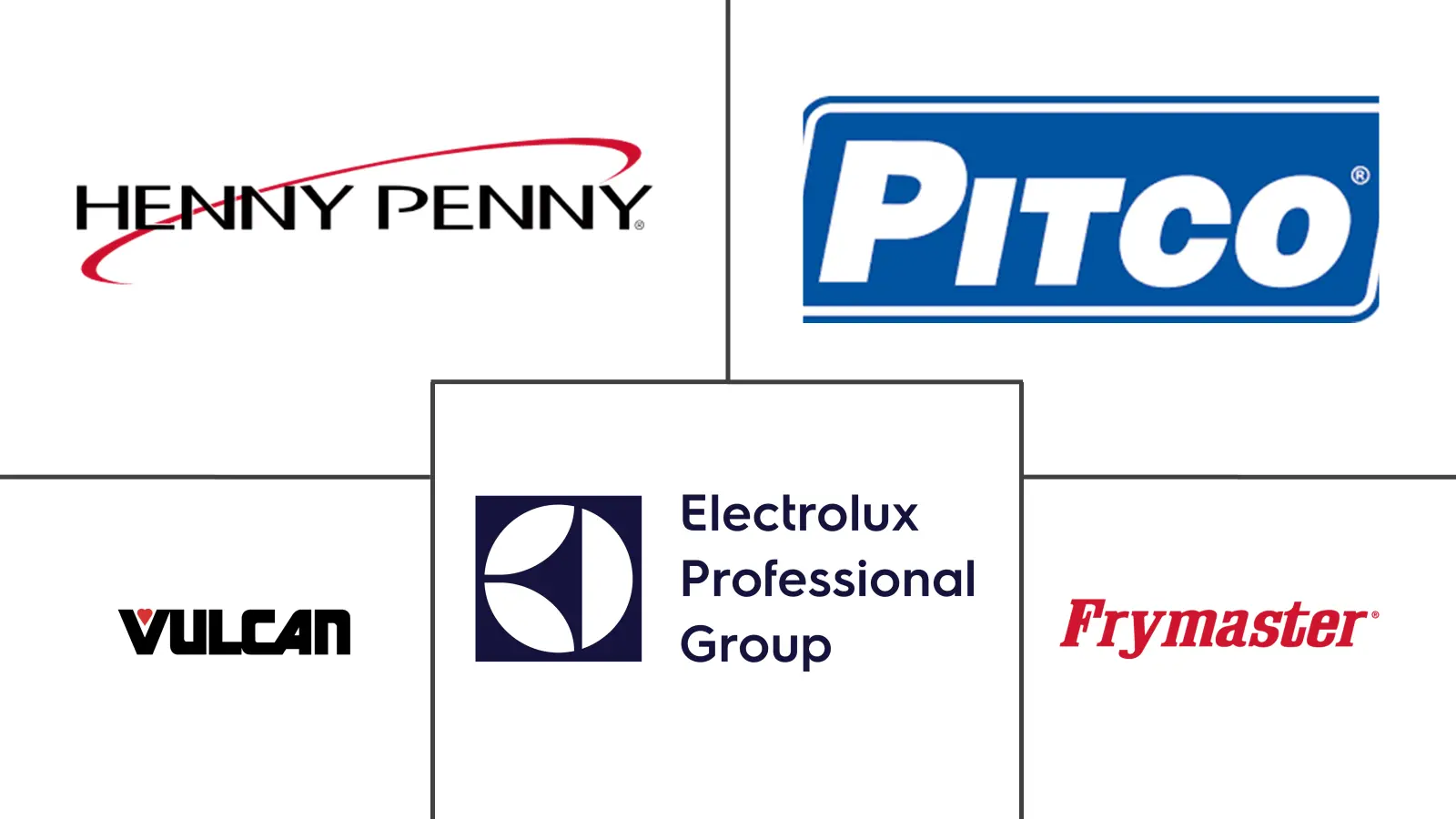Deep Fryers Market Size and Share

Deep Fryers Market Analysis by Mordor Intelligence
The Deep Fryers Market size is estimated at USD 674.21 million in 2025, and is expected to reach USD 895.62 million by 2030, at a CAGR of 5.84% during the forecast period (2025-2030).
The deep fryers market size reached USD 674.21 million in 2025 and, paced by a 5.84% CAGR, is forecast to achieve USD 895.62 million by 2030. This steady climb reflects resilient foodservice demand, consistent capital expenditure on kitchen upgrades, and an equipment replacement cycle that rewards energy-efficient models. Expansion of quick-service restaurant (QSR) footprints, rising adoption of ventless solutions inside ghost kitchens, and mandated efficiency standards have combined to push operators toward high-performance fryers that lower utility bills and ensure menu consistency. Manufacturers are responding with induction heating, IoT-enabled controls, and advanced oil-management modules that curb waste and downtime. Competitive dynamics remain moderate as several global brands pursue bolt-on acquisitions to broaden portfolios while regional specialists capture niche demand for specialty and ventless units.
Key Report Takeaways
- By product type, floor-standing fryers held 49.08% of the deep fryers market share in 2024, while ventless models are advancing at a 9.80% CAGR through 2030.
- By heating source, gas units commanded 58.44% of the deep fryers market size in 2024; induction technology is projected to expand at an 11.40% CAGR between 2025-2030.
- By end user, QSR & FSR restaurants captured 42.76% revenue share in 2024, whereas food trucks and cloud kitchens are forecast to grow at a 12.50% CAGR to 2030.
- By distribution channel, supermarkets & hypermarkets captured 35.64% of sales in 2024, whereas online marketplaces are forecast to grow at a 10.20% CAGR through 2030.
- By geography, North America led with 32.58% revenue share in 2024; Asia-Pacific is set to post the quickest 8.70% CAGR through 2030.
Global Deep Fryers Market Trends and Insights
Drivers Impact Analysis
| Driver | (~) % Impact on CAGR Forecast | Geographic Relevance | Impact Timeline |
|---|---|---|---|
| Expansion of QSR chains | +1.2% | North America, Asia-Pacific | Medium term (2-4 years) |
| Rising demand for convenience & fried snacks | +0.9% | Global urban markets | Long term (≥ 4 years) |
| Energy-efficient fryer upgrades | +0.8% | North America & EU expanding to APAC | Medium term (2-4 years) |
| Ghost-kitchen demand for ventless fryers | +0.7% | Major metro areas worldwide | Short term (≤ 2 years) |
| “Foodvenience” in c-stores fuelling fryer sales | +0.5% | North America, Europe, APAC | Medium term (2-4 years) |
| Urbanization boosting compact household fryer demand | +0.4% | Asia-Pacific core, spill-over to MEA | Long term (≥ 4 years) |
| Source: Mordor Intelligence | |||
Expansion of QSR Chains
Global QSR revenue is projected to cross USD 1.5 trillion in 2025, adding upward of 200,000 new jobs and fueling consistent equipment purchases[1]National Restaurant Association, “Restaurant Industry Primed for Growth in 2025,” restaurant.org. Franchise rollouts standardize kitchen packages, making the deep fryers market a direct beneficiary of turnkey store formats that require identical, high-throughput units across networks. Major QSR chains are standardizing on energy-efficient models to control operating costs across their expanding footprints, creating volume purchase opportunities for manufacturers. Many operators specify ENERGY STAR-qualified models to alleviate margin pressure from utility costs, accelerating volume purchasing. In emerging Asian markets, Western-style chicken and French-fry concepts are scaling rapidly, giving global suppliers a larger installed base. Combined, these factors underpin consistent baseline growth, cushioning the industry from cyclical dips in discretionary spending.
Rising Demand for Convenience & Fried Snacks
Busy urban lifestyles are boosting consumption of grab-and-go meals, and c-stores are seizing the opportunity by adding compact fry stations that deliver fresh fried chicken, donuts, and regional snacks. The so-called “foodvenience” trend is translating into new unit sales, particularly countertop and specialty fryers designed for smaller footprints. Urbanization patterns are amplifying this demand, as dense population centers create opportunities for grab-and-go food concepts that rely heavily on frying equipment. Menu innovation around plant-based proteins and vegetable chips requires precise temperature controls to preserve texture, nudging operators toward premium models with smart sensors. Household penetration of small fryers is also climbing in densely populated Asian cities where kitchen space is limited but demand for indulgent foods remains strong.
Energy-Efficient Fryer Upgrades
ENERGY STAR-certified commercial fryers cut energy use by up to 35% versus baseline units, saving electric models roughly 2,390 kWh and USD 260 each year and gas units about 50 MMBTU and USD 410[2]U.S. Environmental Protection Agency, “Commercial Fryers,” energystar.gov. Compliance mandates such as New York State’s 50% minimum cooking-energy efficiency for gas fryers and 83% for electric designs reinforce an upgrade cycle. Similar rules under U.S. DOE 10 CFR Part 431 are spurring R&D spending on induction coils, advanced insulation, and standby-mode optimization. The uptake is fastest in chain restaurants that can quantify paybacks across dozens of locations. California's pre-rulemaking initiatives for commercial food service equipment are considering enhanced efficiency standards and certification requirements that will further drive technology adoption.
Ghost-Kitchen Demand for Ventless Fryers
The proliferation of ghost kitchens and cloud-based food delivery operations is creating specialized demand for ventless fryer technologies that enable flexible facility utilization without traditional hood systems. Delivery-only concepts prefer equipment that sidesteps expensive hood systems. Ventless units integrate catalytic converters and multi-stage filtration that absorb smoke and grease, enabling installation in converted office or retail spaces. This flexibility supports rapid brand launches and multi-concept kitchens operating from one facility. Food trucks likewise adopt ventless fryers to remove logistical hurdles tied to local exhaust codes; a factor reflected in the segment’s 9.80% CAGR. Manufacturers highlight low installation costs and plug-and-play operation to win share in this growth pocket.
Restraints Impact Analysis
| Restraint | (~) % Impact on CAGR Forecast | Geographic Relevance | Impact Timeline |
|---|---|---|---|
| Health shift toward air fryers | -0.8% | Developed markets | Long term (≥ 4 years) |
| Edible-oil price volatility | -0.6% | Global, more severe in import-dependent nations | Short term (≤ 2 years) |
| Stringent efficiency/emission standards | -0.4% | North America & EU, expanding globally | Medium term (2-4 years) |
| Labor shortage driving automation over legacy fryers | -0.3% | Developed markets | Short term (≤ 2 years) |
| Source: Mordor Intelligence | |||
Health Shift Toward Air Fryers
Consumer health consciousness is driving a significant shift toward air frying technologies, which use minimal oil while achieving similar texture and flavor profiles to traditional deep frying. Growing awareness of dietary fats is pushing consumers and institutional feeders toward hot-air circulation ovens that mimic fried textures with little oil. Academic work has highlighted aldehyde formation during deep-frying, further amplifying health concerns. Commercial kitchens in schools and hospitals increasingly specify air fryers for menu items such as breaded fish or seasoned vegetables. While throughput remains lower than immersion, the perception of healthier food can divert a fraction of future replacement sales away from traditional models, particularly in Europe and North America. However, the technology's limitations in high-volume commercial applications and inability to replicate certain texture characteristics of oil-immersion frying create market segmentation rather than complete substitution, with traditional deep fryers maintaining dominance in QSR and high-throughput operations.
Edible-Oil Price Volatility
Fluctuating edible oil prices create operational uncertainty for commercial fryer users, with recent market disruptions highlighting supply chain vulnerabilities. A 38% decline in U.K. oilseed rape yields in 2024, plus Mediterranean droughts, pushed olive-oil prices up 39%, underscoring the cost risk operators face[3]George Smeeton, “Cooking Oil Price Shock,” eciu.net. Commodity-trader concentration adds speculative layers to price swings, eroding margins for fry-centric menus. In response, chains are investing in filtration systems, automatic oil-quality sensors, and low-volume fry vats that stretch every gallon. Nonetheless, cost uncertainty can delay planned fryer upgrades in favor of all-purpose ovens. The volatility is driving innovation in oil-saving fryer designs and automated monitoring systems that optimize oil usage and replacement cycles.
Segment Analysis
By Product Type: High-Volume Dominance With Ventless Upswing
Floor-standing units represented 49.08% of 2024 revenue, cementing their role as workhorse equipment for QSR chains that demand batch consistency during peak traffic. The deep fryers market size for this subsegment is expected to expand alongside store count additions and replacement cycles after 7-9 years of use. Ventless models, though only 6.4% of 2024 shipments, will log the fastest 9.80% CAGR. Ghost-kitchen operators prefer the no-hood architecture that trims upfront build-out costs, and c-stores tap the format for incremental snack programs. Specialty fryers for donuts and fish attract premium price points, aided by precision thermostats and tailored vat geometries that improve yield.
Across the forecast window, countertop models will capture independent cafés and limited-menu concepts looking for sub-5 kW units. Pressure fryers hold niche relevance for fried-chicken chains; rapid cooking at lower temperatures reduces oil degradation, a selling point amid cost spikes. Collectively, product diversification is raising average selling prices and reinforcing aftermarket revenue streams for baskets, heating elements, and filtration accessories.
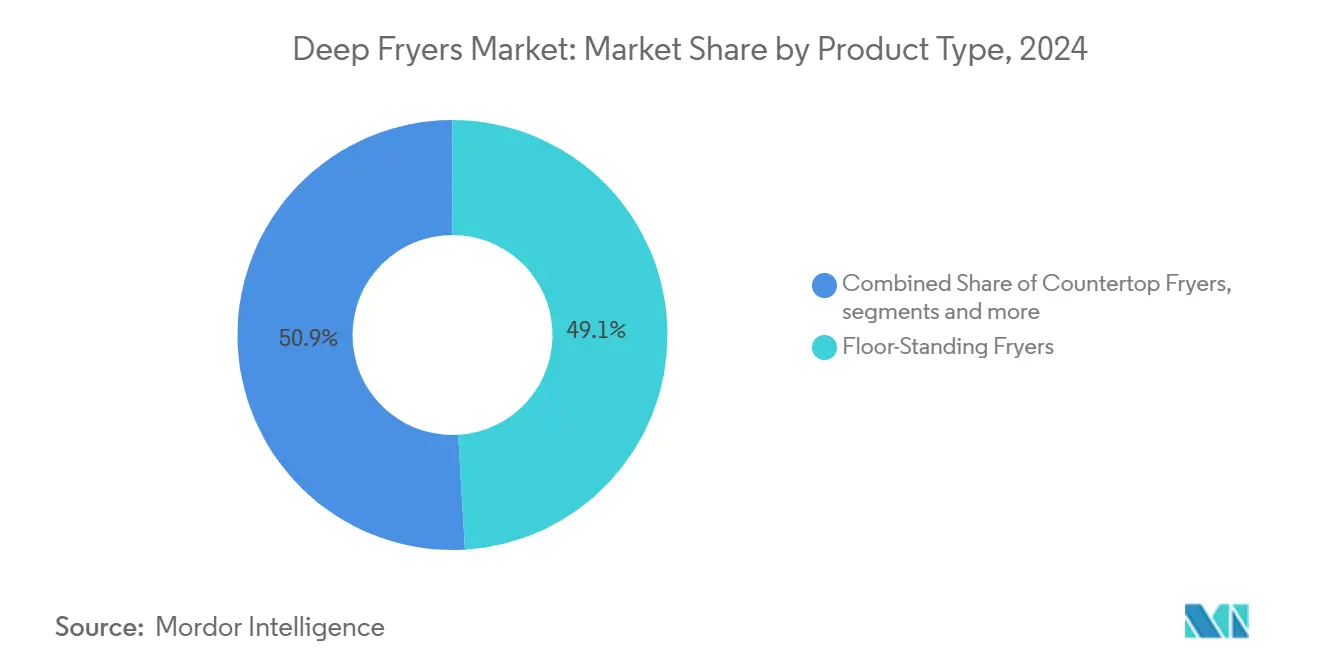
Note: Segment shares of all individual segments available upon report purchase
By Heating Source: Induction Emerges from Niche to Necessity
Gas-fired vats earned 58.44% of 2024 sales due to inexpensive fuel and quick heat recovery, favored by high-throughput kitchens. Electric lines find traction in malls and health-care campuses where gas lines are restricted. The deep fryers market share of induction systems is currently below double digits, yet the 11.40% CAGR positions technology as a force by 2030. Induction coils deliver near-instant temperature correction, vital for maintaining product quality across varying load sizes and menu rotations. An added benefit is cooler ambient temperatures, improving employee comfort and lowering HVAC expenses.
Municipal efficiency ordinances and building electrification codes emerging in California, New York City, and parts of Europe are tilting future purchase decisions toward electricity or induction. Manufacturers are bundling cloud-connected sensors that log energy use, letting operators document compliance and secure potential utility rebates. Continued grid decarbonization could reinforce the advantages of total-cost-of-ownership advantages, narrowing the operating-cost gap with gas.
By End User: Traditional Restaurants Steady, Cloud Kitchens Accelerate
QSR & FSR venues controlled 42.76% of deep fryers market demand in 2024 and continue to anchor replacement cycles every 8-10 years. Heavy production levels drive wear-and-tear, making proactive swap-outs essential to food safety and brand uniformity. Hotels and resorts maintain stable purchases driven by banquet operations and multi-outlet dining facilities. The deep fryers market size attributed to institutional buyers—schools, hospitals, military bases—benefits from public-sector funding tied to nutritional and equipment-sanitation mandates.
Food trucks and cloud kitchens will post the strongest 12.50% CAGR. Smaller, flexible footprints force operators to specify compact or ventless solutions, supporting growth in mid-priced countertop and split-vat formats. As third-party delivery apps proliferate, ghost kitchens rely on high-throughput fry units to satisfy simultaneous virtual brands, from chicken wings to tempura vegetables, without cross-flavor contamination.
By Distribution Channel: Digital Platforms Reshape Procurement
Brick-and-mortar appliance stores and specialized dealers still drive most commercial sales, offering site planning, installation, and service contracts. However, online marketplaces are growing 10.20% per year as buyers leverage side-by-side comparison tools, transparent pricing, and accelerated lead times. Commercial operators increasingly order replacement vats, baskets, and spare heating elements online, cutting phone-based order cycles. The direct-sales route remains entrenched for high-ticket packages that include cookline layout, custom exhaust, and financing.
Household fryers, while a minor revenue share, see supermarkets and hypermarkets dominate impromptu purchasing, especially during festival seasons, where fried snacks are central to celebrations. E-commerce sites appeal to millennial households seeking compact, digitally controlled units with preset modes for fries or battered seafood.
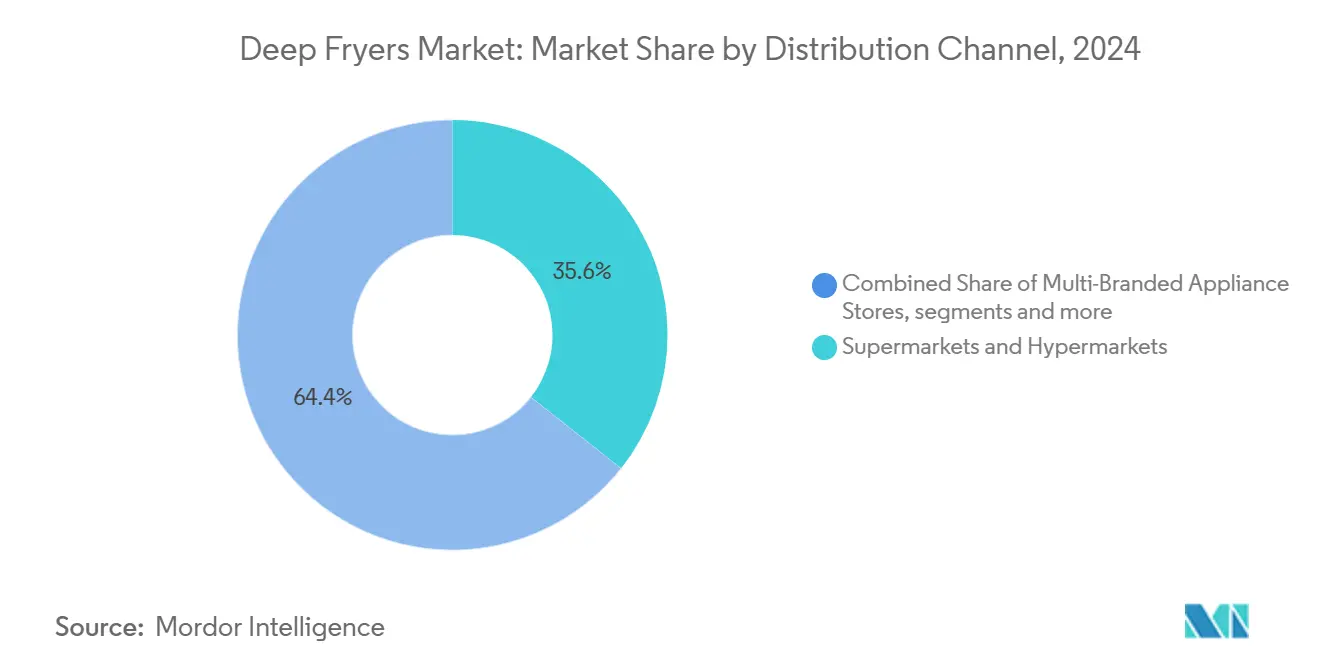
Note: Segment shares of all individual segments available upon report purchase
Geography Analysis
North America, at 32.58% of 2024 turnover, combines mature chain penetration with stringent energy codes that stimulate replacement demand. The ENERGY STAR rebate ecosystem, plus record USD 14.2 billion equipment investment by U.S. restaurants in 2022, underpins volume stability. Canada’s impending federal efficiency mandates should mirror U.S. trajectories, enlarging the regional market for certified models.
Asia-Pacific is the fastest-growing zone, advancing 8.70% annually through 2030. Urbanization and middle-class expansion in China, India, and Southeast Asia are spurring Western QSR expansion and homegrown street-food chains alike. Local manufacturing clusters in Guangdong and Tamil Nadu give multinational brands a cost-efficient supply base, while e-commerce penetration accelerates household fryer adoption. Government MSME grants for food-processing startups further enlarge the addressable customer pool.
Europe maintains incremental growth as restaurants modernize cooklines to satisfy ecodesign rules that demand lower idle-energy rates. Deep fryers market size gains are tied to replacement, not greenfield construction, though Eastern European quick-service operators are rolling out value-priced chicken and pizza chains that depend heavily on fry technology. Middle East & Africa and South America, though with sub-10% shares today, exhibit opportunity pockets in tourism hubs and supermarket deli expansions. Currency volatility and import duties remain headwinds, but localized assembly partnerships are emerging to shorten lead times.
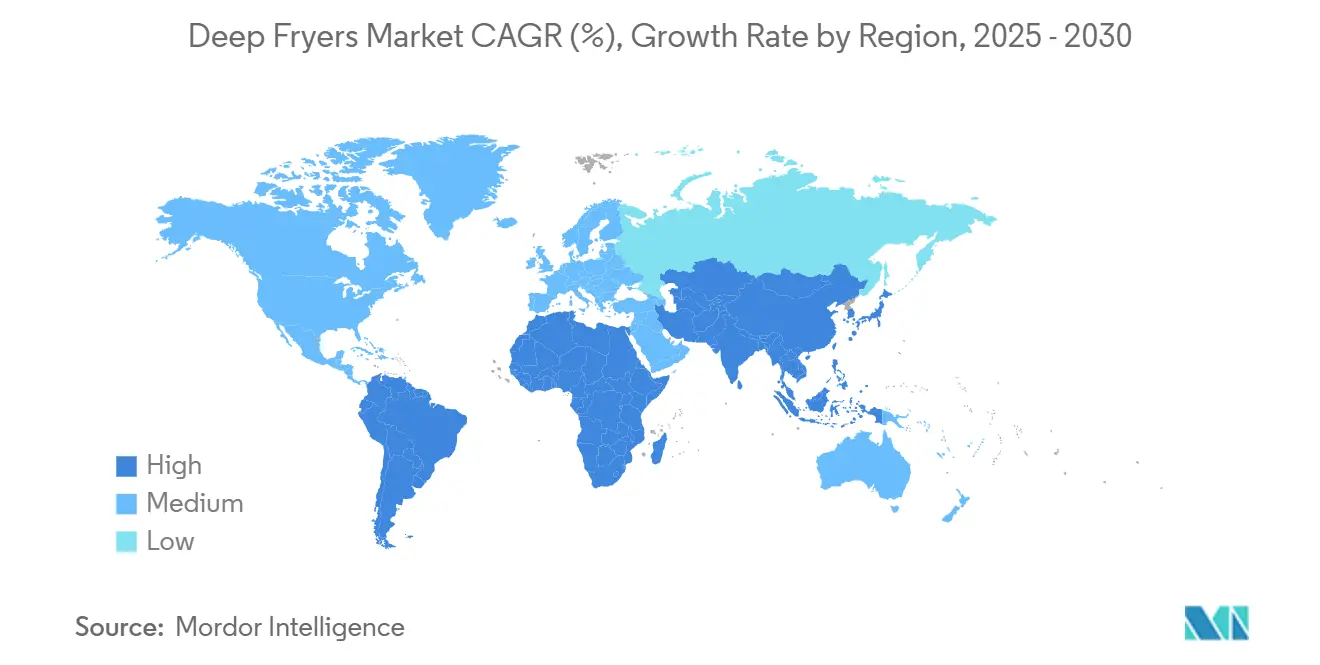
Competitive Landscape
The sector demonstrates moderate concentration, with a handful of global conglomerates complemented by agile regional manufacturers. Middleby leads through a portfolio that includes Pitco and TurboChef and is sharpening its strategic focus by spinning off its food-processing division. Henny Penny differentiates via pressure and open-vat fryers and recently added six master dealers to boost global reach. Electrolux Professional bundles fryers with warewashing and beverage systems to deliver turnkey packages for hospitality clients.
Technology is the primary battleground. Middleby brands secured eight 2024 Kitchen Innovations Awards for self-filtering vats that sync with cloud dashboards. Regional specialists are carving out niches in ventless and induction platforms to exploit the growth of ghost kitchens and electrification mandates. Acquisitions remain a favored tactic; Middleby’s purchase of Emery Thompson extends dessert preparation capabilities that complement fried-chicken menu bundles. Service networks, financing solutions, and rapid-response parts distribution are emerging as decisive factors in winning multi-unit chain contracts.
Deep Fryers Industry Leaders
-
Frymaster (Welbilt)
-
Henny Penny
-
Pitco (Middleby)
-
Vulcan (ITW)
-
Electrolux Professional
- *Disclaimer: Major Players sorted in no particular order
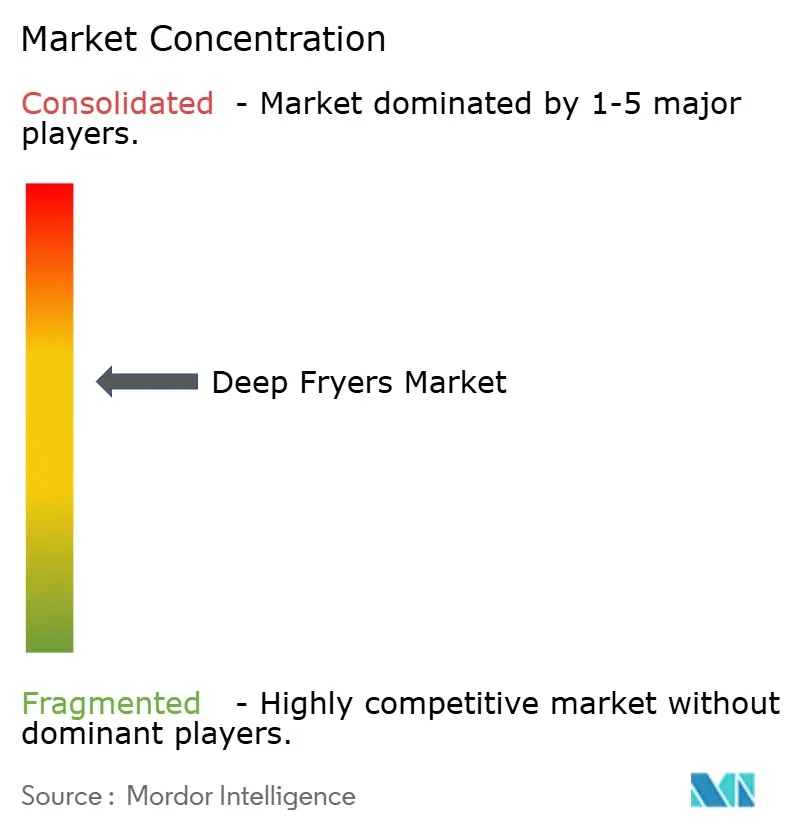
Recent Industry Developments
- February 2025: Middleby announced plans to spin off its food-processing division into a separate public company by early 2026, sharpening its commercial-kitchen focus.
- January 2025: Henny Penny appointed six new master dealers to strengthen its international distribution footprint.
- December 2024: Electrolux Professional outlined a strategic roadshow, citing operations in 110 countries and a target professional-equipment market of USD 31 billion.
- October 2024: Middleby acquired Emery Thompson to diversify into frozen-dessert equipment adjacent to fryer-centric QSR dessert menus.
Global Deep Fryers Market Report Scope
A deep fryer is an electronic appliance used in the kitchen to cook various food products. Gas and electric deep fryers are available for domestic and commercial purposes. Deep fryers are available in nest baskets, ventilation systems, and electronic temperature controls.
A deep fryer's market is segmented into product type (electric deep fryers and gas deep fryers), capacity (2L, 2L-5L, 5L-8L, 8L-14L, and over 14L), end user (households, quick-service, and full-service restaurants), distribution channel (offline and online), and geography (North America (United States, Canada, Mexico, and Rest of North America), Asia-Pacific (India, China, Japan, Australia, and Rest of Asia-Pacific), South America (Brazil, Argentine, and Rest of South America), Europe (United Kingdom, Germany, Italy, and Rest of Europe), and Middle East and Africa (South Africa, United Arab Emirates, and Rest of Middle East and Africa)). The report offers market size and forecasts for the deep fryers market in value (USD) for all the above segments.
| Floor-Standing Fryers |
| Countertop Fryers |
| Pressure Fryers |
| Ventless Fryers |
| Specialty Fryers (Donut, Fish, etc.) |
| Gas Fryers |
| Electric Fryers |
| Induction Fryers |
| Household |
| Quick-Service (QSR) and Full-Service Restaurants (FSR) |
| Hotels & Resorts |
| Food Trucks & Cloud Kitchens |
| Others (Institutional & Catering etc) |
| Supermarkets & Hypermarkets |
| Multi-Branded Appliance Stores |
| Online Marketplaces |
| Direct Sales |
| North America | United States |
| Canada | |
| Mexico | |
| South America | Brazil |
| Argentina | |
| Chile | |
| Peru | |
| Rest of South America | |
| Europe | United Kingdom |
| Germany | |
| France | |
| Italy | |
| Spain | |
| BENELUX | |
| NORDICS | |
| Rest of Europe | |
| Asia-Pacific | India |
| China | |
| Japan | |
| South Korea | |
| Australia | |
| South East Asia | |
| Rest of Asia-Pacific | |
| Middle East and Africa | United Arab Emirates |
| Saudi Arabia | |
| South Africa | |
| Nigeria | |
| Rest of Middle East and Africa |
| By Product Type (Value) | Floor-Standing Fryers | |
| Countertop Fryers | ||
| Pressure Fryers | ||
| Ventless Fryers | ||
| Specialty Fryers (Donut, Fish, etc.) | ||
| By Heating Source (Value) | Gas Fryers | |
| Electric Fryers | ||
| Induction Fryers | ||
| By End User (Value) | Household | |
| Quick-Service (QSR) and Full-Service Restaurants (FSR) | ||
| Hotels & Resorts | ||
| Food Trucks & Cloud Kitchens | ||
| Others (Institutional & Catering etc) | ||
| By Distribution Channel (Value) | Supermarkets & Hypermarkets | |
| Multi-Branded Appliance Stores | ||
| Online Marketplaces | ||
| Direct Sales | ||
| By Geography (Value) | North America | United States |
| Canada | ||
| Mexico | ||
| South America | Brazil | |
| Argentina | ||
| Chile | ||
| Peru | ||
| Rest of South America | ||
| Europe | United Kingdom | |
| Germany | ||
| France | ||
| Italy | ||
| Spain | ||
| BENELUX | ||
| NORDICS | ||
| Rest of Europe | ||
| Asia-Pacific | India | |
| China | ||
| Japan | ||
| South Korea | ||
| Australia | ||
| South East Asia | ||
| Rest of Asia-Pacific | ||
| Middle East and Africa | United Arab Emirates | |
| Saudi Arabia | ||
| South Africa | ||
| Nigeria | ||
| Rest of Middle East and Africa | ||
Key Questions Answered in the Report
How fast is the deep fryers market expected to grow through 2030?
It is forecast to post a 5.84% CAGR, taking revenue from USD 674.21 million in 2025 to USD 895.62 million by 2030.
Which product type is gaining share the quickest?
Ventless models lead with a 9.80% CAGR because ghost kitchens and food trucks want hood-less installations to save on build-out costs.
Why are induction fryers drawing interest?
Induction heating delivers precise temperature control and up to 35% energy savings, helping operators meet emerging efficiency mandates.
What region offers the strongest expansion outlook?
Asia-Pacific, with an 8.70% CAGR, benefits from urbanization and QSR rollouts across China, India and Southeast Asia.
Which companies are the key players?
Middleby, Henny Penny and Electrolux Professional jointly hold just over half of worldwide shipment volume, giving them considerable influence over product standards and service networks.
How are rising oil prices impacting fryer design choices?
Volatile oil prices are pushing operators toward models with advanced filtration and low-volume vats that reduce consumption and extend oil life, helping offset input-cost swings.
Page last updated on:
